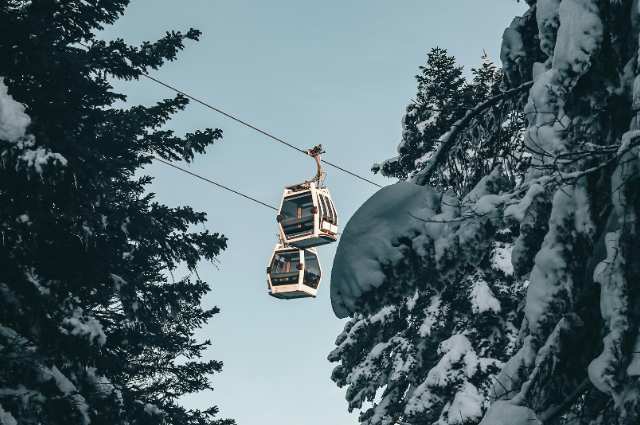
Shimla, one of the most beautiful hill stations, which is also known as the Queen of Hills, is tussling with severe traffic problems. People who have travelled recently with their vehicles know what it feels like having being stuck in long traffic jams even before reaching the city. To escape the summer heat for the cool, fresh mountain air and beautiful views, it’s so near, yet so far. Many travellers only wish that they could have wings to soar over the chaos and reach their destination in no time, especially to avoid the endless honking and slow crawl. During holidays or peak seasons, it becomes much worse, where cars just barely move, and the highway becomes a long trail of slow-moving cars. Around 10,000 cars arrive daily, which causes a lot of inconvenience to both locals and visitors. But soon, all these problems are going to be solved, as a 14 km ropeway is going to be constructed, which will be the world’s second longest after Bolivia’s ropeway, which is around 32 km long connecting La Paz and El Alto. But this will be Asia’s largest ropeway.
This ambitious project will stretch between Parwanoo and Shimla and will cut the travel time down to about two hours. The ropeway will be having 15 stations in its route, which includes Maa Tara Devi Temple, Court Complex (Chakkar), Tutikandi Parking Complex, ISBT, Tunnel No. 103, Railway Station, Victory Tunnel, Old Bus Stand, Boarding Area Station Near the Lift, Lakkar Bazaar Area, IGMC Hospital, Navbahar, Secretariat, and finally Sanjauli. The project has embarked and will cost around Rs 1734.40 crore by the Ropeway and Rapid Transport System Development Corporation, which would be under the Public-Private Partnership (PPP) model with the Government of Himachal Pradesh. The total length of the ropeway is 13.79 km. Principal Secretary (Transport) R D Nazim said that the New Development Bank will be financing most of the project, about 80%, according to NDTV. It has also given the green light for all early-stage works, including the approval of initial tenders and starting procedures. Around 2000 people will be travelling in both directions every hour. Later, it will be increasing to 6000 persons for two-way travel by 2059. There will be 660 cabins, with each having a carrying capacity of about 8-10 passengers. The stations will arrive at every two to three minutes. According to the Ministry of Tourism in the Himachal Pradesh Government, the project will revolutionize the transportation system of Shimla by offering the most modern, eco-friendly option that will enhance connectivity and reduce traffic, which will improve air quality as well as increase tourism.
This new ride will give visitors a unique experience by gliding them high above the ground and enjoying stunning sights of nature and old-style buildings from the sky. Not only will the travel be easier and more fun, but it’s also expected to bring in more tourists. That means local hotels, food places, and craft sellers could see more customers. As tourists start exploring areas around Shimla that they may have missed before, it could open up new chances for local people to earn money and find jobs. As Himachal Pradesh is at the forefront of a nature-friendly tourism scheme allies itself with the state’s guarantee towards eco-sustainable advancement. By cutting several vehicles on the road, the ropeway will help lower carbon emissions, which will make it a sustainably trustworthy solution. Safety, which is the top priority for any mass project, here also it is same as being the main concern here. The latest and most advanced cable car systems are being used to make sure everything runs safely and smoothly.
The ropeway will be developed step by step even though the official timeline has not been shared till now. But once it starts working, it will be sure that that it makes a big impact. It will not only strengthen Shimla’s role in the modern infrastructure but could also encourage a wave of similar ropeway projects across the country. Some people might even call it a “ropeway revolution”. According to Mukesh Agnihotri, Himachal Pradesh deputy chief minister, all documents which are related to forest clearance under the Forest Clearance Act (FCA) have been uploaded in the portal. There will be different route lines in the ropeway project, which are named the Monal Line, Deodar Line and Apple Line. If we look into the reports, they state that the project is expected to provide direct employment to over 250 people and indirect employment to around 20,000 people. Sunder Singh Thakur, the Chief Parliamentary Secretary, said that the ropeway will help make travel around the town smoother by cutting down traffic. He added that the new ropeway to Bijli Mahadev, situated in Kullu, will be a major step forward and bring positive change to the region.
We can see that there are approximately 25,000 ropeways all over the world, while India only has 20 ropeways, so when it’s constructed, there would be a bird’s eye view of Shimla’s forests and mountains, which might stimulate visitors to appreciate and care more for nature and the environment. If this project becomes successful, it could motivate other hill stations to invest in similar eco-friendly transportation and tourism infrastructure. It could also go beyond tourism and business and be a valuable educational tool, as many schools and colleges might organize visits for students to learn about geography, sustainable tourism, along mountain ecosystems. If there are emergencies like landslides, then the ropeway could also serve as an alternate route for safe transport or for rescue operations. It could also create a chance to show the culture of the people of Himachal Pradesh by turning ropeway cabins and stations into places that showcase local art, music, or even folklore. By these standards, people, with time, might change their focus to immersive, peaceful moments rather than just crowded road trips.
